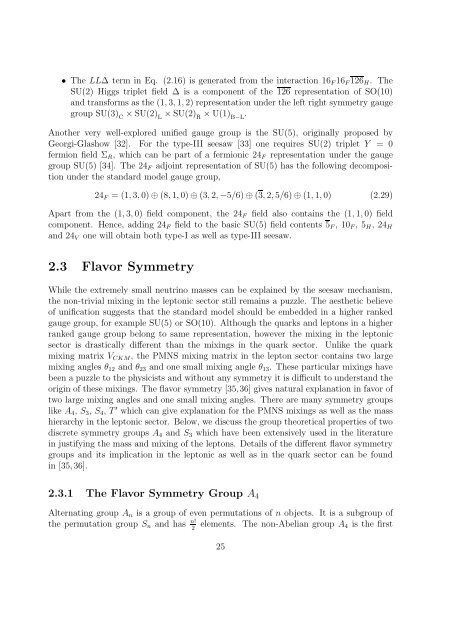PHYS08200604017 Manimala Mitra - Homi Bhabha National Institute
PHYS08200604017 Manimala Mitra - Homi Bhabha National Institute
PHYS08200604017 Manimala Mitra - Homi Bhabha National Institute
You also want an ePaper? Increase the reach of your titles
YUMPU automatically turns print PDFs into web optimized ePapers that Google loves.
• The LL∆ term in Eq. (2.16) is generated from the interaction 16 F 16 F 126 H . The<br />
SU(2) Higgs triplet field ∆ is a component of the 126 representation of SO(10)<br />
and transforms as the (1,3,1,2) representation under the left right symmetry gauge<br />
group SU(3) C<br />
×SU(2) L<br />
×SU(2) R<br />
×U(1) B−L<br />
.<br />
Another very well-explored unified gauge group is the SU(5), originally proposed by<br />
Georgi-Glashow [32]. For the type-III seesaw [33] one requires SU(2) triplet Y = 0<br />
fermion field Σ R , which can be part of a fermionic 24 F representation under the gauge<br />
group SU(5) [34]. The 24 F adjoint representation of SU(5) has the following decomposition<br />
under the standard model gauge group,<br />
24 F = (1,3,0)⊕(8,1,0)⊕(3,2,−5/6)⊕(3,2,5/6)⊕(1,1,0) (2.29)<br />
Apart from the (1,3,0) field component, the 24 F field also contains the (1,1,0) field<br />
component. Hence, adding 24 F field to the basic SU(5) field contents 5 F , 10 F , 5 H , 24 H<br />
and 24 V one will obtain both type-I as well as type-III seesaw.<br />
2.3 Flavor Symmetry<br />
While the extremely small neutrino masses can be explained by the seesaw mechanism,<br />
the non-trivial mixing in the leptonic sector still remains a puzzle. The aesthetic believe<br />
of unification suggests that the standard model should be embedded in a higher ranked<br />
gauge group, for example SU(5) or SO(10). Although the quarks and leptons in a higher<br />
ranked gauge group belong to same representation, however the mixing in the leptonic<br />
sector is drastically different than the mixings in the quark sector. Unlike the quark<br />
mixing matrix V CKM , the PMNS mixing matrix in the lepton sector contains two large<br />
mixing angles θ 12 and θ 23 and one small mixing angle θ 13 . These particular mixings have<br />
been a puzzle to the physicists and without any symmetry it is difficult to understand the<br />
origin of these mixings. The flavor symmetry [35,36] gives natural explanation in favor of<br />
two large mixing angles and one small mixing angles. There are many symmetry groups<br />
like A 4 , S 3 , S 4 , T ′ which can give explanation for the PMNS mixings as well as the mass<br />
hierarchy in the leptonic sector. Below, we discuss the group theoretical properties of two<br />
discrete symmetry groups A 4 and S 3 which have been extensively used in the literature<br />
in justifying the mass and mixing of the leptons. Details of the different flavor symmetry<br />
groups and its implication in the leptonic as well as in the quark sector can be found<br />
in [35,36].<br />
2.3.1 The Flavor Symmetry Group A 4<br />
Alternating group A n is a group of even permutations of n objects. It is a subgroup of<br />
the permutation group S n and has n!<br />
2 elements. The non-Abelian group A 4 is the first<br />
25
















